Matsumoto Castle - Pride of the City: Part 1
By Deborah Klens-Bigman, Ph.D
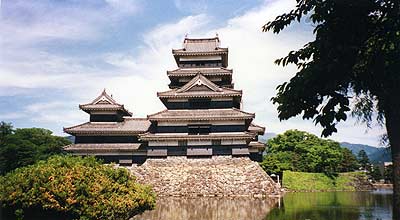
Editor’s Note: This is the first of a two part
article on Matsumoto Castle. Readers might also be interested in Klens-Bigman’s
article on another famous Japanese historic Samurai castle Shirasagi
located near Osaka in Himijijo. See: ”A
visit to the "Samurai
Castle" – Himejijo.”
When I told my hairdresser
that I was going to Matsumoto Castle, she said, "Be sure to get a seat next to the window on the train. The
view of the mountains is wonderful!" I need not have worried. The
woman at the travel agency at Asakusa who booked me knew exactly what
to do - window seat, on the side where the Japanese Alps first come into
view. Spectacular.
It was June and the snow-capped peaks were tremendously inviting, but
not this trip, unfortunately. My destination this time around was Matsumoto
Jo, an intact battle castle built at the end of the Sengoku Jidai (Warring
States Period), around 1593. Like Shirasagi Jo in Himeji, the subject
of a previous essay, Matsumoto Jo was finished in time for the peace
of the Edo Period (1603-1868). Since it was never attacked, and was spared
lighting strikes that might have otherwise destroyed it, Matsumoto Jo
gives us a glimpse of the state-of-the-art fortifications of four hundred
years ago.
When I first arrived at Matsumoto, I was a little disappointed that
it is not a quaint little town, but a bustling, small city. On the other
hand, quaint little towns do not have battle castles. After settling
at the hotel, I set out, camera in hand, to take some photos of the castle
exterior, since it was too late in the afternoon for admission to the
place itself.
Historical interest is just about all that Shirasagi Jo and Matsumoto
Jo have in common, however. In the first place, if you did not know there
was a castle in Matsumoto, there is practically no way of knowing from
outside appearances. Matsumoto Jo is a hirajiro, a castle built on a
plain, rather than a hill like Shirasagi. At one point the castle no
doubt dominated the landscape of smaller buildings. Nowadays, however,
you have to go in search. Matsumoto is dead center of the modern city,
on the other side of the business district that is near the train station.
It is worth the hunt. The castle sits resplendent, surrounded by a surprisingly
large park landscaped with pine and cherry trees. A wisteria-hung pavilion
provides shaded area for about 30 people to sit and admire the view of
the castle and the Alps beyond. The afternoon I came by to take photos,
the place was full of citizens, smoking, talking and enjoying the shade
on an almost impossibly hot afternoon.
There's a reason for their abiding interest. Though Matsumoto Jo is
not as well known as Shirasagi or some other castles, it is the center
of civic pride in this small, prosperous city. Surrounded by a wide moat,
it basks in dark splendor.
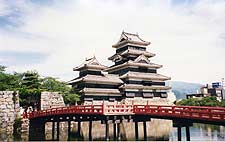 |
Matsumoto Jo on a hot spring day. The Northern Tower (left) and
the Main Tower (right), with the vermillion bridge in the foreground.
The Southern Wing and Moon-Viewing Tower are not visible in this
photo. |
Matsumoto Jo is small and mostly black, giving the place a dramatically
forbidding look. The first fortification was erected on the site in the
early 14th century. The Ishikawa clan began construction of the castle
as it now exists in 1592 and it was finished about a year later. Successive
clan members made more improvements until the current layout was finished
by about 1614. (The dates of construction vary a little, according to
which source I consulted. The dates I have chosen to include should therefore
be considered approximate.)
The existing complex consists of a small Northern Tower, which is connected
to the Main Tower by a roofed passage, and a Southern Wing. Three moats
originally surrounded Matsumoto Jo. The center one still surrounds the
castle, and remnants of the others can be seen nearby. Interestingly,
a group of Edo Period residences has been preserved on one side, and
one moated section hosts a set of craft and antique shops, all reminiscent,
in their way, of Edo Period life.
The next morning was bright and hot. Since it was too early to visit
the castle proper, I spent some time walking around the several blocks
of historical houses. These are now used for various shops and businesses,
but their original look is more or less intact. One notable feature of
these houses is the massive thickness of the walls, keeping in warmth
in the wintertime, and staying cool in the summer.
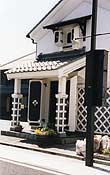 |
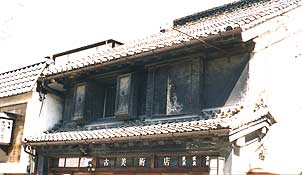 |
(Left) An Edo Period building near
Matsumoto Jo. Note the thickness of the walls, as evidenced by
the massive
front door. (Right) The windows of an Edo Period building with
shutters open (left) and closed (right). |
I reached the castle proper by means of a vermillion bridge that stretches
from the park to the base of the Northern Tower, which is also the entrance
to the castle complex. The Northern Tower, or Inui Kotenshu, is four
stories high, but typically, looks like three stories from the outside
(see photo below). The Northern Tower is constructed inside by a series
of rough-hewn beams, which come together in the roof of the topmost floor.
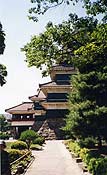 |
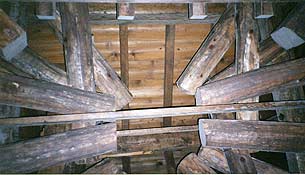 |
(Left)The Northern Tower
as one steps off the vermillion bridge. The Moon-Viewing Tower
is on the left. (Right) Beams converge at the top of the
Northern Tower.
|
At this point the visitor is introduced to the defensive openings in
the outer walls. Since Matsumoto Jo was constructed about 50 years
after the introduction of firearms, the walls have openings for both
arrows (yazama) and guns (teppozama). Shuttered openings in the floors,
called ishiotoshi, provided air circulation but more importantly from
a defensive standpoint, allowed defenders to hurl rocks on would-be
invaders as they tried to scale the sloping walls of the castle. (Historian
Karl Friday has pointed out the importance of stones as defensive weapons,
so this was no small feature of castle architecture.)
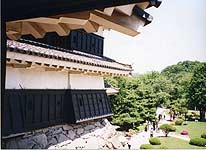
|
Exterior of the Main tower
showing teppozama and yazama. The ishiotoshi are in the overhanging
portions of the wall.
|
|
A roofed passageway, the Watari Yagura, connects the
Northern Tower to the Main Tower. The passageway runs from the second
floor of the Northern Tower to the first floor of the Main Tower.
Whether the passage was constructed to provide a secure access to
the Main Tower, or whether to protect occupants from the fierce winter
weather that affects the region was never explained, but both seem
likely. |
The first floor of the Main Tower, or Tenshu, was used for storing
weapons and supplies, but the outer perimeter is a wide passage
set 50 centimeters below
the rest of the floor. This warriors' running passage" or Musha Bashira
formed the first line of castle defense. As a placard inside puts it, "this
passage was constructed to allow samurai in full armor - during times of battle
- to run around the interior and defend the castle from attack," by means
of the yazama, teppozama and ishiotoshi.
Steep, uneven stairs connect the floor levels inside the Main Tower.
The stairways do not connect with each other but are set at some
distance apart from floor to floor, to better prevent someone from
rapidly ascending to the upper levels. |
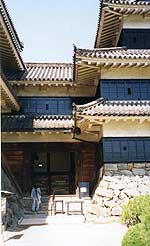 |
The Watari Yagura (left) connects
the Northern Tower (right) with the Main Tower.
|
|
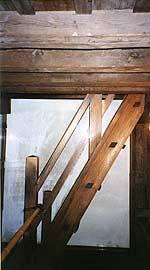 |
Steep wooden stairways (with the modern addition of
handrails) made rapid ascents more difficult. |
End of Part 1
About The Author:
Deborah Klens-Bigman is Manager and Associate Instructor of iaido at
New York Budokai in New York City. She has also studied, to varying extents,
kendo, jodo (short staff), kyudo (archery) and naginata (halberd). She
received her Ph.D in 1995 from New York University's Department of Performance
Studies where she wrote her dissertation on Japanese classical dance
(Nihon Buyo). and she continues to study Nihon Buyo with Fujima Nishiki
at the Ichifuji-kai Dance Association. Her article on the application
of performance theory to Japanese martial arts appeared in the Journal
of Asian Martial Arts in the summer of 1999. She is married to artist
Vernon Bigman. For FightingArts.com she is Associate Editor for Japanese
Culture/Sword Arts.
|